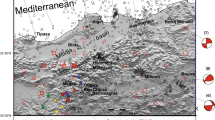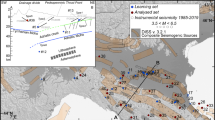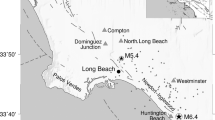Abstract
We analyze previously published geodetic data and intensity values for the M s = 8.1 Shillong (1897), M s = 7.8 Kangra (1905), and M s = 8.2 Nepal/Bihar (1934) earthquakes to investigate the rupture zones of these earthquakes as well as the amplification of ground motions throughout the Punjab, Ganges and Brahmaputra valleys. For each earthquake we subtract the observed MSK intensities from a synthetic intensity derived from an inferred planar rupture model of the earthquake, combined with an attenuation function derived from instrumentally recorded earthquakes. The resulting residuals are contoured to identify regions of anomalous intensity caused primarily by local site effects. Observations indicative of liquefaction are treated separately from other indications of shaking severity lest they inflate inferred residual shaking estimates. Despite this precaution we find that intensites are 1–3 units higher near the major rivers, as well as at the edges of the Ganges basin. We find evidence for a post-critical Moho reflection from the 1897 and 1905 earthquakes that raises intensities 1–2 units at distances of the order of 150 km from the rupture zone, and we find that the 1905 earthquake triggered a substantial subsequent earthquake at Dehra Dun, at a distance of approximately 150 km. Four or more M = 8 earthquakes are apparently overdue in the region based on seismic moment summation in the past 500 years. Results from the current study permit anticipated intensities in these future earthquakes to be refined to incorporate site effects derived from dense macroseismic data.
Similar content being viewed by others
References
Ambraseys N 2000 Reappraisal of north-Indian earthquakes at the turn of the 20th Century; Curr. Sci. 79 1237–1250.
Ambraseys N and Bilham R 2000 A note on the Kangra M s = 7.8 earthquake of 4 April 1905; Curr. Sci. 79 101–106.
Ambraseys N and Bilham R 2003 MSK isoseismal intensities evaluated for the 1897 Great Assam Earthquake; Bull. Seismol. Soc. Am. 93 655–673.
Ambraseys N and Douglas J 2004 Magnitude calibration of north Indian earthquakes; Geophys. J. Int. 159(1) 165–206, doi:10.1111/J.1365-246X.2004.02323.X
Avouac J P 2003 Mountain Building, Erosion, and the Seismic Cycle in the Nepal Himalaya; Adv. Geophys. 46 10.1016/S0065-2687(03)46001-9.
Beresnev I A and Atkinson G M 1997 Generic finite-fault model for ground-motion prediction in eastern North America; Bull. Seismol. Soc. Am. 89 608–625.
Beresnev I A and Atkinson G M 2002 Source parameters of earthquakes in eastern and western North America based on finite-fault modeling; Bull. Seismol. Soc. Am. 92 695–710.
Bettinelli P, Avouac J-P, Flouzat M, Jouanne F, Bollinger L, Willis P and Chitrakar G R 2006 Plate motion of India and interseismic strain in the Nepal Himalaya from GPS and DORIS measurements; J. Geod. doi:10.1007/s00190-006-0030-3.
Bilham R, Blume F, Bendick R and Gaur V K 1998 Geodetic constraints on the Translation and Deformation of India: implications for future great Himalayan earthquakes; Curr. Sci. 74(3) 213–229.
Bilham R 2001 Slow tilt reversal of the Lesser Himalaya between 1862 and 1992 at 78E and bounds to the southeast rupture of the 1905 Kangra earthquake; Geophys. J. Int. 144 1–23.
Bilham R and England P 2001 Plateau pop-up during the great 1897 Assam earthquake; Nature 410 806–809.
Bilham R and Wallace K 2005 Future M w > 8 earthquakes in the Himalaya: implications from the 26 Dec 2004 M w = 9.0 earthquake on India’s eastern plate margin; Geol. Surv. India Spec. Publ. 85 1–14.
Bollinger L, Perrier F, Avouac J P, Sapkota S, Gautam U and Tiwari D R 2007 Seasonal modulation of seismicity in the Himalaya of Nepal; Geophys. Res. Lett. 34 L08304, doi:10.1029/2006GL029192.
Bomford G 1937 Leveling in Bengal and Bihar 93–97. In: Survey of India Geodetic Report 1936, (eds) Couchman H J, Geodetic Branch Survey of India, Dehra Dun, pp. 97.
Boore D M 2001 Comparisons of ground motions from the 1999 Chi-Chi earthquake with empirical predictions largely based on data from California; Bull. Seismol. Soc. Am. 91 1212–1217.
Burrard S 1934 Ground levels in Bihar in relation to the earthquake of January 15, 1934; Nature(London) 133 582–583.
Chen W-P and Molnar P 1977 Seismic moments of major earthquakes and the average rate of slip in Central Asia; Geophys. Res. 82 2945–2969.
Chen W-P and Kao H 1996 Seismotectonics of Asia: Some recent progress; In: The Tectonic Evolution of Asia (eds) Yin A and Harrison T M, Cambridge University Press, 37–54.
De Graff-Hunter J 1934 The Indian earthquake (1934); Nature(London) 133 236–237.
Duda S 1934 Secular seismic energy release in circum-Pacific belt; Tectonophys. 2 409–452.
Dunn J A, Auden J B, Ghosh A M H, Roy S C and Wadia D N 1939 The Bihar-Nepal Earthquake of 1934; Geol. Surv. India Memoir. 73 1–391.
Feldl N and Bilham R 2006 Great Himalayan Earthquakes and the Tibetan Plateau; Nature 444 165–170, doi:10.1038/nature05199.
Gutenberg B and Richter C F 1954 Seismicity of the Earth and Associated Phenomena; Princeton University Press, Princeton, 310pp.
Hough S E 2000 On the scientific value of ‘unscientific’ data; Seismol. Res. Lett. 71 483–485.
Hough S E, Martin S, Bilham R and Atkinson G 2002 The 26 January, 2001 Bhuj, India earthquake: observed and predicted ground motions; Bull. Seismol. Soc. Am. 92 2061–2079.
Hough S E, Bilham R, Ambraseys N and Feldl N 2004 Revisiting the 1897 Assam and 1905 Kangra earthquakes in northern India: Site response, Moho reflections, and a triggered earthquake; Curr. Sci. 88 1632–1638.
Middlemiss C S 1905 Preliminary account of the Kangra earthquake of 4 April 1905; Geol. Soc. India Memoir. 32 Pt. 4: 258–294.
Middlemiss C S 1910 The Kangra earthquake of 4 April 2005; Geol. Surv. India Memoir. 38 405.
Molnar P 1987 The distribution of intensity associated with the 1905 Kangra earthquake and bounds on the extent of rupture; J. Geol. Soc. India 29 221.
Mori J and Helmberger D 1996 Large-amplitude Moho reflections (SmS) from Landers aftershocks, southern California; Bull. Seismol. Soc. Am. 86 1845–1852.
Nandy D R, Choudhury A K, Chakraborty C and Narula P L 1993 Gateological Survey of India, Bihar-Nepal earthquake, August 20, 1988; Spec. Publ. Geol. Surv. India 31, 104 pp.
Oldham R D 1899 Report on the great earthquake of 12th June 1897 (incl. the reports by P. Bose, G. Grimes, H. Hayden, T. LaTouche, and E. Vredenburg); Geol. Surv. India Memoir 29 1379.
Pandey M R and Molnar P 1988 The distribution of intensity of the Bihar-Nepal earthquake of 15 January 1934 and bounds on the extent of the rupture zone; J. Geol. Soc. Nepal 5 22–44.
Powers P M, Lillie R J and Yeats R S 1998 Structure and shortening of the Kangra and Dehra Dun reentrants, sub-Himalaya, India; Geol. Soc. Am. Bull. 110 1010–1027.
Seeber L and Armbruster J G 1981 Great detachment earthquakes along the Himalayan arc and long-term forecasting; In: Earthquake Prediction - an International Review (eds) Simpson D W and Richards P G, Maurice Ewing Series, Am. Geophys. U. 4 259–277.
Singh D D and Gupta H K 1980 Source dynamics of two great earthquakes of the Indian subcontinent; the Bihar-Nepal earthquake of January 15, 1934 and the Quetta earthquake of May 30, 1935; Bull. Seismol. Soc. Am. 70(3) 757–773.
Singh S K, Ordaz M, Dattatrayam R S and Gupta H K 1999 A spectral analysis of the 21 May 1997, Jabalpur, India, earthquake (M w = 5.8) and estimation of ground motion from future earthquakes in the Indian shield region; Bull. Seismol. Soc. Am. 189 1620–1630.
Somerville P and Yoshimura J 1990 The influence of critical Moho reflections on strong ground motions recorded in San Francisco and Oakland during the 1989 Loma Prieta earthquake; Geophys. Res. Lett. 17 1203–1206.
Wald D J, Quitoriano V, Heaton T H and Kanamori H 1999 Relationships between peak ground acceleration, peak ground velocity, and modified Mercalli intensity in California; Earthquake Spectra 15 557–564.
Wallace K, Bilham R, Blume F, Gaur V K and Gahalaut V 2005 Surface deformation in the region of the 1905 Kangra M w = 7.8 earthquake in the period 1846-2001; Geophys. Res. Lett. 32(15) L15307, 10.1029/2005GL022906.
Wessel P and Smith W H F 1991 Free software helps map and display data, EOS; Trans. Am. Geophys. U. 72 441–445.
Wu F, Sheehan A, Huang G C and Monsalve G 2003 Source mechanisms, seismicity, and velocity structures in the Himalayan region; Indo-US Workshop on Seismicity and Geodynamics 49 Hyderabad.
Yeats R S, Nakata T, Faraj A, Fort M, Mirza M A, Pandey M R and Stein R S 1992 The Himalayan frontal fault system; Ann. Tect. 6 85–98.
Author information
Authors and Affiliations
Corresponding author
Rights and permissions
About this article
Cite this article
Hough, S.E., Roger, B. Site response of the Ganges basin inferred from re-evaluated macroseismic observations from the 1897 Shillong, 1905 Kangra, and 1934 Nepal earthquakes. J Earth Syst Sci 117 (Suppl 2), 773–782 (2008). https://doi.org/10.1007/s12040-008-0068-0
Received:
Revised:
Accepted:
Published:
Issue Date:
DOI: https://doi.org/10.1007/s12040-008-0068-0




